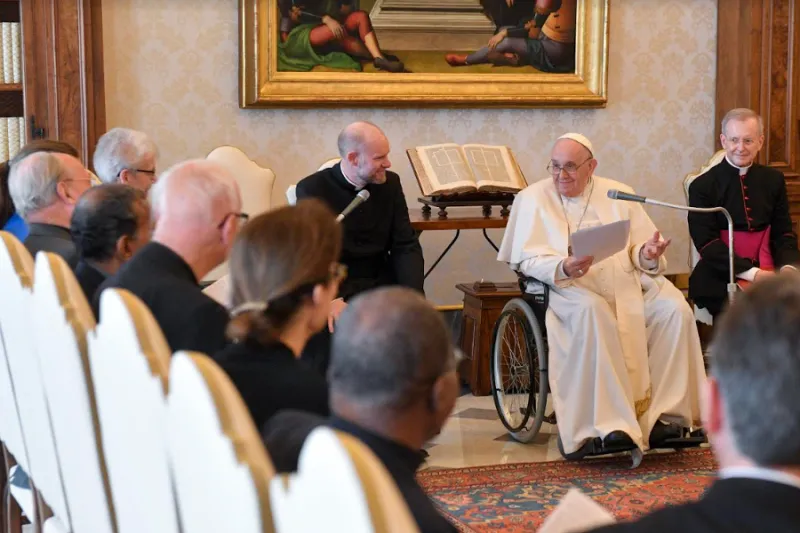
Vatican City, May 13, 2022 / 12:20 pm (CNA).
Pope Francis said on Friday that members of the Anglican Communion are “valued traveling companions” as Catholics take part in a worldwide synodal process.
Speaking to the Anglican-Roman Catholic International Dialogue Commission (ARCIC) on May 13, the pope said he hoped that Anglicans would contribute to the two-year initiative leading to the Synod on Synodality in Rome in 2023.
He said: “As you know, the Catholic Church has inaugurated a synodal process: for this common journey to be truly such, the contribution of the Anglican Communion cannot be lacking. We look upon you as valued traveling companions.”
The 85-year-old pope noted that in July he is due to travel to South Sudan with Justin Welby, the Archbishop of Canterbury and leader of the Anglican Communion.
The pope, who has been making his public appearances in a wheelchair since May 5 due to a torn ligament in his right knee, said: “As part of this concrete journey, I wish to recommend to your prayers an important step. Archbishop Justin Welby and the Moderator of the Church of Scotland, two dear brothers, will be my traveling companions when, in a few weeks’ time, we will at last be able to travel to South Sudan.”
“The visit was postponed on account of the troubles in that country. My brother Justin is sending his wife ahead of us for the works of preparation and charity. This is the fine work he is doing with his wife, as a couple, and I thank her very much.”
He added: “Ours will be an ecumenical pilgrimage of peace. Let us pray that it may inspire Christians in South Sudan and everywhere to be promotors of reconciliation, patient weavers of concord, capable of saying no to the perverse and useless spiral of violence and of arms.”
The Anglican Communion is the world’s third-largest Christian communion after the Catholic Church and Eastern Orthodox Church. It has an estimated 85 million members in more than 165 countries.
ARCIC was founded in 1967 by the then Archbishop of Canterbury Michael Ramsey and Pope Paul VI. Currently in its third phase, the commission’s most recent document is entitled “Walking Together on the Way.”
If you value the news and views Catholic World Report provides, please consider donating to support our efforts. Your contribution will help us continue to make CWR available to all readers worldwide for free, without a subscription. Thank you for your generosity!
Click here for more information on donating to CWR. Click here to sign up for our newsletter.




“[Some] Anglicans are ‘valued traveling companions'”.
I’ll buy that. Like those two on Anglican Unscripted.
This reader recalls a letter to-the-editor to, I think The New Oxford Review, where an Anglican was disconcerted even then, in the early 1980s, over the dialogue between the Catholic Church and the Anglican communion. The Anglican writer asked how could the Catholic Church dialogue with Anglicans when the Anglicans, themselves, had no idea what they themselves believed.
A significant milestone since then, of course, is Pope St. John Paul II’s “Ordinatio Sacerdotalis” regarding the nature of the sacrament of Holy Orders. Probably this more recent clarification (1994), and others, will be useful to help reorient the Anglican-style “synodal wayward” in Germany.
Low Church, broad Church, Anglo Catholic….I wonder which branch of this ecclesial community will be listened too…talk about ideology…we have nothing to learn from heresy and schism only how not to fall into error…the sincerity of individuals who adhere or find themselves in their history as part of this communion..yes we may learn much from individuals..in fact they may achieve a deeper relationship with Christ than countless Catholics..only because those Catholics neglected the means of holiness..Word of God, Sacraments, prayer and the spiritual and corporal works of mercy. This is mind-blowing confusion.